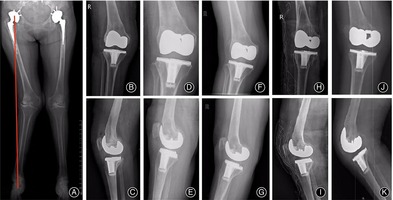- Record: found
- Abstract: found
- Article: found
Effect of Knee Valgus Deformity on Symptomatic Venous Thromboembolism and Prosthesis Revision Risk after Total Knee Arthroplasty: A Multicenter Retrospective Study

Read this article at
Abstract
Objective
Symptomatic venous thromboembolism (VTE) and prosthesis failure are the most serious complications after total knee arthroplasty (TKA). However, whether knee valgus deformity aggravates these complications has not been fully clarified. To study the difference between perioperative symptomatic VTE and prosthesis revision rate in patients with valgus knee osteoarthritis by comparing with patients undergoing TKA for varus deformity and analyze the reasons for revision. At the same time, the distribution and radiographic features of lower extremity deep venous thrombosis were recorded.
Methods
The data of patients who underwent TKA in two tertiary hospitals from January 2016 to December 2020 were retrospectively reviewed, and a total of 8917 patients were included. According to preoperative manifestations of knee malformations, all patients were divided into two groups: valgus group ( n = 412) and varus group ( n = 8505). Main indicators included the incidence of symptomatic VTE and prosthesis revision. Secondary outcomes included general information on operative time, Kellgren and Lawrence score, total hospital stay, and total costs. The patient data of the two groups were analyzed by Pearson chi‐square test, Student t test, or Mann–Whitney U test. The revision was evaluated using Kaplan–Meier survival analysis.
Results
The proportion of valgus knees in TKA patients was 4.62% (412/8917). The incidence of VTE was 6.23‰ (53/8505) and 16.99‰ (7/412) in the varus and valgus groups, and the results were statistically different ( p = 0.009). There was no significant difference in echogenicity, number of occluded vessels, and thrombus length between the valgus group ( p = 0.102; p = 0.645; p = 0.684). Patients with valgus deformity had 12.14‰ (5/412) prosthesis revision, the incidence of varus deformity was 4.82‰ (41/8505), and the revision risk of valgus group was 2.5 times higher than varus group, and the results were statistically different ( p = 0.043). The operation time and hospital stay in the valgus group were longer than those in the varus group, and the results were statistically different ( p = 0.018; p < 0.001).
Abstract
To study the difference of perioperative symptomatic venous thromboembolism (VTE) and prosthesis revision rate in patients with valgus knee osteoarthritis by comparing with patients undergoing total knee arthroplasty (TKA) for varus deformity and analyze the reasons for revision. At the same time, the distribution and radiographic features of lower extremity deep venous thrombosis were recorded.
Related collections
Most cited references30
- Record: found
- Abstract: found
- Article: not found
Incidence and time course of thromboembolic outcomes following total hip or knee arthroplasty.
- Record: found
- Abstract: found
- Article: not found
Total knee arthroplasty for severe valgus deformity.
- Record: found
- Abstract: found
- Article: not found
